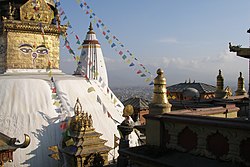Swayambhunath (17824481046)
For the Buddhist Newars in whose mythological history and origin myth as well as day-to-day religious practice, Swayambhunath occupies a central position, it is probably the most sacred among Buddhist pilgrimage sites. For Tibetans and followers of Tibetan Buddhism, it is second only to Boudhanath.
The Swayambhunath complex consists of a stupa, a variety of shrines and temples, some dating back to the Licchavi period. A Tibetan monastery, museum and library are more recent additions. The stupa has Buddha's eyes and eyebrows painted on. Between them, the number one (in Devanagari script) is painted in the fashion of a nose. There are also shops, restaurants and hostels. The site has two access points: a long stairway with 365 steps, leading directly to the main platform of the temple, which is from the top of the hill to the east; and a car road around the hill from the south leading to the southwest entrance [Wikipedia.org]Relevantní obrázky
Relevantní články
SvajambhúnáthSvajambhúnáth či Swayambhunath je starobylý náboženský komplex na vrcholu kopce v údolí Káthmándú, západně od centra Káthmándú. Tibetský název místa znamená 'Vznešené stromy', pro mnoho druhů stromů, které se na kopci nacházejí. Šingkun však může být z tamangského bhaského názvu komplexu, Swayambhu, což znamená "samosprašný." Pro buddhistické Névárce, v jejichž mytologické historii a mýtu o původu i každodenní náboženské praxi zaujímá Swayambhunath ústřední postavení, je pravděpodobně nejposvátnějším mezi buddhistickými poutními místy. Pro Tibeťany a vyznavače tibetského buddhismu je hned na druhém místě za Boudhou. Swayambhunath je hinduistický název. .. pokračovat ve čtení













